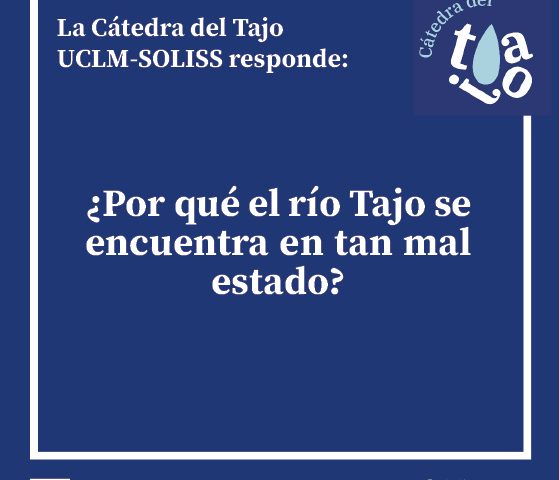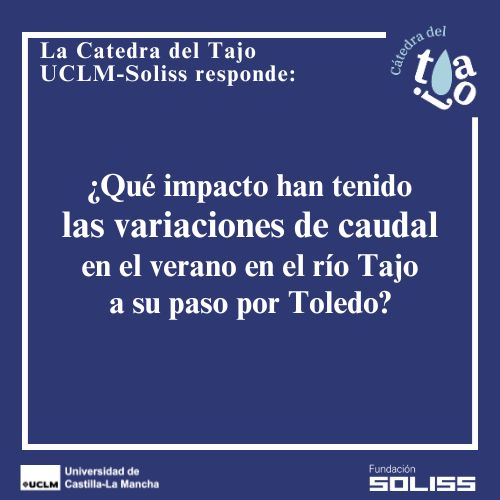
Conferencia-coloquio: «El Tajo, educación ambiental y el papel de la mujer». 5 de marzo en Santa Cruz de la Zarza.
24/02/2022
«La disminución de los recursos del Tajo y su necesidad de recuperación hacen que el trasvase Tajo-Segura tenga los días contados»
16/03/2022- First installment of The Chair Responds, a monthly delivery of popular articles to respond to the main problems of the hydrographic basin. In this initial, we ask ourselves and try to answer the reason for the poor condition of the Tagus axis.
At school we were taught that the Tagus River began in the Montes Universales, that with its 1,007 kilometers in length it was the longest river in the Iberian Peninsula and that, after passing through Aranjuez, Toledo and Talavera, it reached Lisbon where it flowed into the Atlantic Ocean. Any student could imagine a river with large banks, full of life, a powerful river befitting the title of being “the longest.” However, today is the day when that imagined river does not correspond to reality. Since the 70s, as a consequence of industrialization, the concentration of population in large centers and agricultural pollution (agriculture and livestock), Its waters have a very high level of pollution, which degenerates into foam in some of its sections., with its degraded, disconnected, altered banks and a systematic lack of flow that makes it find itself very far from its natural conditions., prior to human action. And the thing is, the Tagus River, as some studies tell us, is a depleted river, mistreated in all its sections, contaminated and altered ad nauseam. It is not a unique case in Spain, but it is one of the most important and paradigmatic.
Insufficient water purification
On the one hand, the cause of its poor physical-chemical state is found, fundamentally, in the insufficient purification of the treatment plants in its territory. The metropolitan area of Madrid, which now has close to seven million inhabitants, represents 82% of the population of the basin and the main urban and industrial area of the country. Two of its basins (those of the Jarama and Guadarrama rivers) collect practically all of the discharges from this large number of people and their economic activities. And these flow into the Tagus. Madrid's purification systems, despite treating practically all of the water in the region, are incapable of preventing the Jarama and Guadarrama rivers from transporting millions of liters of water loaded with pollutants daily and which have the Madrid rivers in a perpetual state of poor quality.
The problem of transfer and the lack of ecological flows
On the other hand, the cause of its lack of river dynamics is a consequence of the Tajo-Segura transfer. In 1981, the pharaonic project of the largest transfer between basins in our country began to divert water from the headwaters of the Tagus. The transfer was based on the fallacious and repeated ad nauseam “hydromit” of the peninsular hydrological imbalance: at the head of the Tagus “were left over” between 600 and 1,000 cubic hectometers per year that should contribute to the economic development of the southeast. Years later, it was possible to demonstrate that there were no such surpluses, that the contributions at the head are already 50% below estimates, a figure that will increase between 15 and 25% in the coming years as a result of climate change.
But, the most serious thing of all is that these two issues occur at the same time in the same river. All this contaminated water reaches a Tagus River with meager flows. The reasons why the river is in such poor condition is that the Tagus is unable to dilute this enormous concentration of pollutants due to lack of flow. It must be taken into account that the Jarama River provides three times more flow in Aranjuez than that carried by the Tagus River. The foam and grease that are visible from the historic bridges of Toledo are not really the Tagus River, but are the dirt contributed by the Jarama and the treatment plants upstream.
Hydroelectric regulation in the Extremaduran Tagus
And there is still more. Aguas abajo de Talavera, la explotación hidroeléctrica ha convertido al Tajo en una concatenación de presas. El río ha desaparecido entre una y otra. Son aguas embalsadas gestionadas con criterios empresariales. Las especies de vegetación y de fauna propias de un río han sido desplazadas por otras ajenas en un ecosistema simplificado y apenas diverso, un río desnaturalizado.
The management and governance of the demarcation
Given this accumulation of factors, the Tajo Hydrographic Confederation finds itself with the transfer law, which conditions its management because it has a higher rank than the Hydrological Plan. But it does have in its hands the control of pollution and the improvement of river dynamics through the establishment of an ecological flow regime that will help achieve the good ecological status of the water masses of the middle section of the Tagus River. The rulings of the Supreme Court ruled in favor of those who defend the river, but to this day these flows are still not met. The result for the river ecosystem has been a reduction in the quality of its banks and its fauna. If a river is stripped of its water, the most important part of its being is stripped away.
Added to these factors, and others of perhaps lesser significance, is the problem in governance. It is urgent that the basin management body prioritize the achievement of the objectives of the Water Framework Directive using all the environmental and social tools that it provides.
Until this is achieved, the Tagus River will continue to be the paradigm of lack of flow, lack of quality and altered banks.




